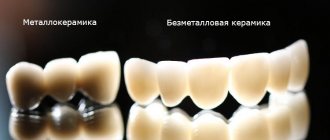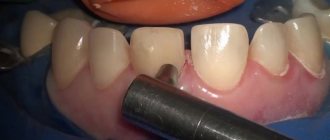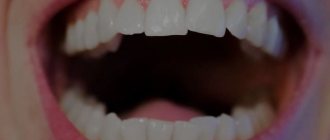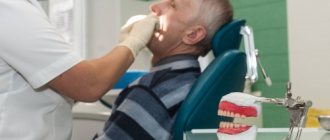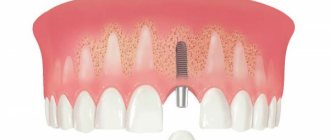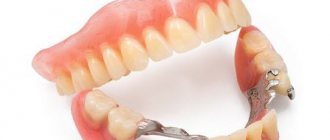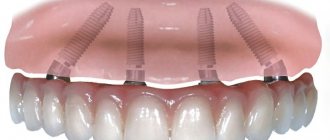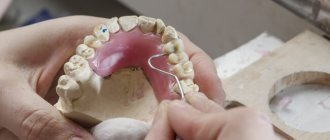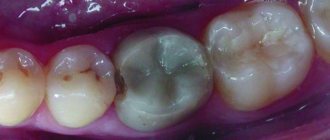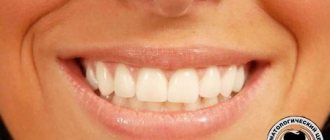Metal-free crowns are orthopedic structures for restoring the integrity of the coronal part of the tooth. Metal is not used in such products; modern materials are used - lithium disilicate (ceramics), zirconium dioxide, aluminum oxide. The products are durable, biocompatible, hypoallergenic, aesthetic. The service life is more than 15 years. The cost depends on the material and manufacturing technology.
E.Max ceramic crowns and veneers
Attending doctor
Strigin Vladimir Igorevich
Find out the price
Types of materials
Lithium disilicate (E-max ceramic crown)
Our Center installs 2 types of ceramic crowns made of lithium disilicate (glass ceramics). They differ in indications and manufacturing technologies:
- E-max PRESS - available in the form of pressed “tablets”. Orthopedic products are made from it under the influence of high temperatures and pressure. The strength of the material reaches 400 MPa. Suitable for making single crowns and bridges up to 3 teeth in the area of the front teeth. Classic Emax PRESS monochromatic, transparent, inexpensive. A frame is made from it, onto which layers of liquid porcelain and dyes are applied to give the structure a natural shade. We use the improved E-max PRESS Multi, it is more expensive, but has a gradient of color and transparency, so it does not require porcelain coating.
- E-max CAD - lithium disilicate blocks for the manufacture of orthopedic structures on a milling machine under software control using CAD/CAM technology. The material is more durable - up to 450 mPa, can be used for chewing units of the dentition. Robotic production eliminates the human factor, ensures an accurate fit, and eliminates adjustments. The technology makes it possible to produce thin products, so minimal grinding of teeth is required. Coloring the material with a smooth transition of shades from more saturated to transparent allows you to imitate tooth enamel.
Based on zirconium dioxide (zirconium crown)
Products based on zirconium oxide are manufactured by milling using CAD/CAM technology and have a thickness of up to 0.4 mm. The material has properties close to natural tooth enamel and has good light transmission characteristics. It gives the impression of a smooth exit of the tooth unit from the gums - at the exit in the center of the crown the color is saturated, and on the sides and at the cutting edge it is more transparent. Zirconium structures are hypoallergenic and suitable for people suffering from allergic reactions. Crowns rank first in terms of strength (up to 1200 mPa), which allows them to be installed in place of the front and chewing teeth and used in bridges of any length. Strength, biological compatibility, and high aesthetics have made zirconium dioxide a popular material. The only negative is the high cost.
Made from aluminum oxide (Procera technology)
Aluminum oxide is a translucent mineral that belongs to metal-free ceramics. Crowns made from it are less durable than zirconium, but stronger than E-max ceramics. This is enough for installation on the front and chewing teeth, making reliable bridges of different lengths. Aluminum oxide transmits light, is resistant to deformation, biocompatible, hypoallergenic. The aluminum oxide frame is manufactured using CAD/CAM technology in several stages after creating a virtual model of the product. Procera® technology from Nobel Biocare, a leader in the field of metal-free restorations in terms of aesthetic and quality characteristics, is used for production. Crowns are manufactured in a factory in the USA. The cost of products is the highest, as it includes shipping costs.
Temporary plastic crowns can also be classified as non-metal crowns. They are installed during the production of permanent teeth to protect ground teeth and to correct the bite during multiple restorations. Easy to manufacture, inexpensive. But they are not intended for long-term wear - they quickly absorb food coloring and cannot withstand constant chewing loads.
CL-II (glass ceramics)
The materials used in the manufacture of prostheses for this group are similar to the previous ones in their composition. But the main differences are their processing methods and structure. Glass ceramics are characterized by adding crystals to glass or growing them in it. If CL-I group crowns are made manually, then CL-II ceramics are supplied in special blocks.
Glass ceramics are divided into two types:
- CL-IIa. The composition contains a small amount of leucite-feldspathic glass (up to 50%). When the feldspar level is low, the crown material is transparent, so an additional procedure (bonding) is required during preparation. Glass ceramics are used for the same purposes as the ceramic mass of the CL-I group. Their service life is quite long. When using prosthetics, the minimum layer must be at least 0.8 mm. The main advantage is durability. This is achieved due to changes in the coefficient of thermal expansion of leucite, which significantly reduces the risk of cracks in the crown during operation.
- CL-IIb. In the ceramics of this group, the content of leucite-feldspar glass is higher than average (more than 50%). The blanks are made of glass, so they are completely transparent. The next step is growing the crystals, then grinding them and applying them to the first phase (glass). Due to this, greater strength of the material is achieved, since such processing allows the formation of an area of compressive stress. Basically, lithium disilicate (from silica), lithium dioxide, aluminum and potassium oxides, and phosphorus pentoxide are used for the manufacture of prostheses. Not long ago, lithium disilicate reinforced with zirconium (up to 10%) began to be used in prosthetics. The main advantage of this material is its durability and the possibility of performing a single restoration of any tooth.
Advantages and disadvantages
Advantages of metal-free structures:
- biological compatibility, hypoallergenic, metal-free;
- absence of a “gray neck” at the gums, characteristic of metal-ceramics;
- light transmittance, increasing the aesthetics of the product;
- lightness, the ability to install even on weakened teeth;
- absence of strong grinding and depulpation of the tooth;
- no sensitivity to temperature changes;
- preservation of natural shade for a long time;
- service life more than 15 years;
- tight fit to the gum.
The only negative is the high price compared to metal-ceramics, which is compensated by the listed advantages.
Patient reviews
I've been wearing ceramic teeth for three years now. Since I have a natural intolerance to metals, using ceramics was the only option. Before the prosthetics, I was fitted with a temporary plastic structure. It was very uncomfortable with it, as I was constantly afraid that it would crack while eating. At first, after installing a ceramic fixed prosthesis, I was also afraid to eat anything solid, but then I got used to it. And such artificial teeth cannot be distinguished from natural ones at all. I recommend to everyone!
Alexander, St. Petersburg
I installed metal-free ceramics on my front teeth 8 years ago. I'm very pleased with the result. There is no discomfort. I quickly got used to them, and you can’t tell them apart from natural ones at all. I can drink drinks and eat food at any temperature, since there is no sensitivity, but before this my teeth reacted to everything.
And although a lot of time has passed, the shade of the ceramic teeth remains the same.
My dentist promised that if I did not chew hard food (I installed dentures in front), then my teeth would last me at least 15 years. I decided for myself that as soon as this ceramic deteriorates, I will install it again. Larisa, Rostov-on-Don
Indications
- Prosthetics for the first time. If the supporting teeth are strong and healthy, there is no need to depulpate them or sharpen them much. Metal-free products allow you to preserve “living” teeth.
- Replacement of outdated structures. Recently, patients are increasingly seeking to improve aesthetics and quality of life, so they turn to us to replace outdated metal-ceramic crowns.
- Allergy to metal. If metal or metal-ceramic crowns cause discomfort, metal-free crowns are the only option.
- Increased requirements for aesthetics. When a patient requires dentures that are indistinguishable from natural teeth, only a metal-free design is suitable.
- Weak supporting teeth. Metal-free products are lightweight and do not create an increased load on the teeth.
Alternative prosthetic options
Metal ceramics
Metal-ceramic crowns are a budget option for prosthetics. They have high strength, but lack natural aesthetics. Therefore, this method is not recommended for front teeth.
Veneers
Veneers are thin ceramic plates that cover all defects on the vestibular surface of the front teeth. The main requirements for installing veneers are complete preservation of the lingual wall of the tooth, as well as the absence of large chips.
Enamel extension
This is tooth restoration using a filling mass (photopolymer composite). The doctor applies the composite layer by layer to the defect area, illuminating each layer with a photopolymer lamp. However, this method is indicated only when the coronal part is destroyed by less than 1/2.
Comprehensive rehabilitation.
Total prosthetics with metal-free structuresDoctor: Alexey Lebedko Published by Egor Ruzov Dentistry on February 4, 2015
Technologies and manufacturing stages
We give preference to crowns made in 2 ways:
- Milling (CAD/CAM technologies). For manufacturing, the doctor scans the patient’s oral cavity (CAD), digital data is transferred to a computer, where a 3D model is recreated in a special program. The information is transmitted to milling equipment (CAM) to obtain the desired shape from the blanks. This is the main method used in our Center.
- Pressing (used for E-max technology). High pressure and temperature are used to shape the material. The crown is made using a wax structure. It is used less frequently, but is also used at the request of the patient.
Installation
Examination, preparation of the oral cavity
The dentist assesses the patient's condition. If necessary, an x-ray is taken, caries is treated, non-viable units are removed, and professional cleaning is carried out.
Tooth preparation
Gentle grinding is carried out to the thickness of the crown, only the affected tissue is removed. Severely damaged units are strengthened with stump inlays. If necessary, temporary plastic prostheses are installed to protect against destruction while the structures are being prepared.
Taking impressions
It is carried out using impression material or scanning the oral cavity with a camera.
Making a crown
In the laboratory, based on the models, prostheses are made by pressing or milling.
Fitting and correction
The prosthesis is tried on to assess its comfort and fit. If necessary, the crown is sent to the laboratory for final work to adjust the shape of the product.
Installation
The finished prosthesis is attached to the tooth using dental cement for fixation.
After 4-7 days, the patient is scheduled for a follow-up visit for examination and prevention of complications. The entire installation process, taking into account the preparation of the oral cavity, takes from 2 weeks to 2 months, depending on the complexity of the case.
In difficult situations, when restoration of a large number of teeth is required, as well as for doubtful patients, the design of future crowns is first selected and approved:
- First, wax modeling of future structures is carried out on models of the patient’s jaws (Wax-up). You can see your future smile even before the start of prosthetics and make the necessary wishes for adjustments.
- Then the resulting modeled crowns are transferred into the oral cavity in the form of temporary test products (Mock-up), without grinding the teeth. You can evaluate the functionality and check the wearing comfort before starting the main prosthetic work.
Prices
Our Center has developed prices for cases for the installation and production of metal-free crowns. The cost depends on the technology and material, includes:
- manufacturing;
- fittings;
- fixation.
Case prices for products using digital CAD/CAM technologies:
- ceramic crown E.max - 36,000-48,000 rub.
- crown made of zirconium dioxide - 38,000 rubles.
- ceramic crown on a zirconium dioxide frame - 42,000-58,000 rubles.
Lithium disilicate and zirconium dioxide crowns have fixed prices, as they are manufactured in our own laboratory using ZirkonZahn® technology. Prices for aluminum oxide crowns using Procera® technology may vary slightly depending on the ruble exchange rate.
Impressions are paid separately - 3,500 rubles. The price does not depend on the method of obtaining them (impression mass or digital scanning).
In non-standard situations, an individual crown design is required, which is paid separately:
- manual wax modeling Wax-up - RUB 1,600. for 1 unit;
- temporary plastic crowns or Mock-up - RUB 6,000. for 1 unit.
Innovative products E.MAX
The material belongs to glass ceramics: it contains lithium disilicate crystals. The product is prepared in two ways:
- pressing technique. It allows you to increase quality indicators and produce monolithic products that prevent chipping;
- 3D milling. The blocks are processed using automated production on a special milling machine.
Before the procedure, the specialist performs an intraoral scan on the patient, which creates a 3D projection and sets the parameters for the future crown. The finished structure is highly durable, functional and aesthetically pleasing.
Thanks to the optical properties of the glass matrix, Emax has increased light transmittance, which allows it to be as similar as possible to tooth enamel.
Technology for restoring chipped ceramic crowns and when the procedure is justified.
In this publication we will discuss the prices of porcelain crowns.
Here https://www.vash-dentist.ru/protezirovanie/nesemnyie-p/koronki-np/metallicheskuyu-s-napyileniem.html all the most important things about metal crowns with spraying.
Our prices are a guarantee of high quality
Case pricing adopted in our Center may at first seem more expensive than in other clinics. But we use only high-quality materials and never purchase Chinese fakes. In addition, our system is honest - we indicate in advance all possible additional costs, do not hide anything, and do not put patients in an uncomfortable situation when drawing up the final estimate.
Levin Dmitry Valerievich
Chief physician, Ph.D.
Life time
The average service life of metal-free prostheses is 15 years. With proper care they will last longer. The timing depends on the chosen material and location in the dentition. It is of great importance how much the patient complies with the doctor’s instructions for the care of the structure and diet.
In our Center for Private Dentistry “Doctor Levin” there is a guarantee for the integrity and color of metal-free crowns made using digital technology for 25 years. Our orthopedists are confident in their work and the quality of the source material. The warranty periods are confirmed by digital passports for the products.
Care instructions
Metal-free dental products do not require complex procedures. It is enough to follow medical recommendations.
How to properly care for the structure:
- Brush your teeth 2 times a day.
- To remove food debris from interdental spaces, use dental floss.
- After each meal, rinse your mouth with clean water.
- Regularly undergo dental examinations to detect tooth disease or tooth decay in the early stages.
- Eliminate too hard foods (nuts, caramel) from your diet.
- Adjust your diet. Be sure to add foods rich in vitamins and minerals (especially calcium and vitamin D) to the menu.
- It is advisable to use special rinsing solutions that have antiseptic and strengthening properties. They better remove food debris and take care of gum health.
According to reviews from patients who have installed a metal-free crown on a tooth, the structure retains its natural color and has no side effects, thanks to simple care rules.
What is better for the front and chewing teeth?
When choosing a type of orthopedic design, the location of the tooth to be restored is taken into account:
- E-max glass ceramics are suitable for the front ones, as it allows you to achieve a natural shade of enamel;
- It is better to make dentures for molars from zirconium dioxide, which is characterized by increased strength;
- for increased demands on aesthetics, E-max Multi with gradient coloring or translucent crowns made of zirconium or aluminum oxide are suitable;
- For prostheses on implants, only zirconium is recommended for bruxism.
The recommendations described are based on the different requirements for dentures for anterior and chewing teeth. For the former, aesthetics are more important, for the latter - strength and wear resistance.
Sometimes you have to choose from all three options to decide which one is right for your specific situation. The light transmitting characteristics of materials depend on the original color and transparency of your teeth. Fittings are free, but they take time, so you need to plan prosthetics at a time when you can visit the clinic without affecting your business.
Main characteristics
Metal-free crowns include products made from:
- plastics are cheap, but fragile, quickly stain and crack, usually used for temporary prosthetics;
- ceramic composite – consist of composite materials and ceramics;
- ceramics or porcelain - inorganic material obtained by processing nitrides, metal oxides, borides, carbides at high temperatures;
- zirconium dioxide (oxide) - similar in strength to metal, and in aesthetics - similar to ceramics.
When people talk about metal-free orthopedic structures, they usually mean zirconium dioxide and ceramics. The technology for prosthetics with these materials was developed in the 80s of the 20th century, but they began to be used on a large scale in the last ten years.
Despite the high cost, metal-free crowns are very popular
Sometimes patients confuse the concepts “metal-free” and “bimetallic”. The latter term means prostheses made from an alloy of two or more metals: gold, nickel, platinum, chromium, palladium, etc.
The difference between a metal-ceramic crown and non-metal ceramics
Metal-ceramic crowns have been used in orthopedics for more than 35 years. They consist of a frame based on an alloy of chromium with cobalt or nickel and a ceramic coating. The products are durable, can withstand heavy loads, and last more than 10 years. But compared to metal-free products, metal ceramics have a number of disadvantages:
- mandatory depulpation and grinding of the tooth before installation;
- possibility of allergy to metal;
- the risk of gum subsidence and exposure of the metal base;
- chips of ceramics are possible;
- poor light transmission, which makes the prosthesis look unnatural.
In our Center, after switching to digital milling in 2000, we completely abandoned metal-ceramics in favor of metal-free products.
How long will a ceramic prosthesis last?
Ceramic dental crowns have a fairly long service life - with appropriate and careful treatment, they can last up to 10 years or even more. If installing ceramic crowns affects your budget, you can choose an alternative option. These are metal ceramics, ceramic composite, plastic (but only on a temporary basis). Your attending physician will help you choose the best one.
Author: Dulgarov Zh. G. (Thank you for your help in writing the article and the information provided)
